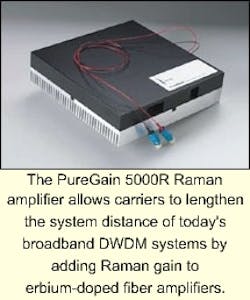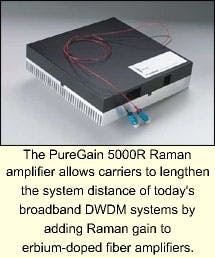Raman amplifiers combine with EDFAs to tackle system-distance limitations
BY MEGHAN FULLER
SYSTEMSRaman amplification, first considered a viable technology in the 1980s, took a back seat in the 1990s following the advent of the erbium-doped fiber amplifier (EDFA), which alleviated the problem of signal power loss. Yet, as lengthening transmission distances become increasingly appealing to long-haul carriers, Raman-amplifier technology has once again garnered interest. A new amplifier from Corning Inc. (Corning, NY) exemplifies this trend.
As an optical signal travels through the fiber, it loses power and must be regenerated. In traditional long-distance systems using EDFAs, an amplifier is placed every 80 to 100 km, and each amplifier is capable of handling 32 to 40 nm at 10 Gbits/sec. Such amplifiers were more than adequate when data rates topped out at 10 Gbits/sec and the number of channels did not exceed 40. How ever, today's carriers need systems that are optimized for higher data rates, more channels, and higher bandwidths-and EDFAs alone may not do the job.
"What is now known with Raman amplification is that you can substantially increase what we call system distance by putting a Raman amplifier in front of each EDFA every 80 km," asserts George Wildeman, product- line manager for Corning's PureGain optical amplifiers.
A Raman pump launches high-power laser light into the fiber in the opposite direction of the optical signal-at the output end of the fiber where the signal is weakest-and that light joins with and strengthens the signal. Using a Raman amplifier in conjunction with an EDFA is comparable to adding an extra EDFA to the center of the span.
Wildeman likens Raman amplification to undersea transmission. "In a transatlantic system, for example, there are no regenerators," he says. "[These systems] have just optical amplifier repeaters. The way they do that is, they space the repeaters close together; they're about 35 to 40 km apart. So what the Raman amplifier is doing is, in an 80-km span, it's putting amplification out in the middle of the span; it's mimicking what is done undersea. You're sort of putting a virtual amplifier out in the middle of the span."The new Corning PureGain 5000R induces stimulated Raman scattering, which creates gain-up to 10 dB-and that, in turn, is used to overcome distance limitations. It features four pumps at two different wavelengths, and each pair of pumps is polarization multiplexed, which doubles the amount of power normally achieved at each wavelength. This en sures that the signal is circularly polarized, which is important be cause Raman gain, when it's launched into the transmission fiber, can be polarization-dependent. The signal, which is coming in the opposite direction, may achieve polarization-dependent gain if the pumps are not polarization- multiplexed.
Using two pairs of pumps simultaneously also enables end users to control the gain curve. An interesting feature of Raman amplification is that Raman gain, when pumped into a given wavelength, appears 100 nm to the right of it, because the pumps are 100 nm shorter than where the gain is required. Having pumps at different wavelengths allows users to shape the curve, to put the peaks and valleys in different spots along the curve. Ex plains Wildeman, "You can overlay two different gain curves, and you can start to add a little bit of gain control to it. And that's what the 10-dB gain-flattened PureGain 5000R Raman amplifier does."
The PureGain 5000R also in cludes the Smart Card, an electronic-gain control card and microprocessor used to monitor both the pump power at different wavelengths and the signal power coming into the device. Using this information, the Smart Card can control the current in the pump, which controls the output power, and this allows end users to shape the gain curve to their specifications. In addition, Corning engineers have measured the Raman gain coefficients of the various fiber types and embedded this knowledge into the Smart Card, enabling it to determine the fiber type and set the gain and pump accordingly.
Corning believes the intelligence of the PureGain 5000R will set it apart from the competition. "There are a lot of pump suppliers that [had been] supplying pumps, and now they are looking at supplying pumps with combiners or p-muxes [polarization multiplexers]. They may provide the two pumps with the p-mux combined, which is, to me, really still a component," says Wildeman. "What Corning has been able to integrate is the Smart module."
While Wildeman admits that many of the OEMs in Corning's customer pool may also be competitors because they also make control cards, he isn't worried. "Our customers are asking us to add more [functionality to these modules] because they don't have the time to do every single smart control on every single card they are putting out in the network, and Corning's got the smarts and the wherewithal to do it," he asserts.
Raman amplification may allow carriers to in crease their system distance and data rates and tighten channel spacings, but Charles Bur-ger, technology analyst for the "Gilder Technology Report," warns that such advancements do not come without a price. "High-powered Raman pump lasers impose technological and manufacturing challenges as great as EDFA 980 [nm] pump lasers," he says, and they can add both cost and complexity to the network. Its future success "will depend on advances in WDM where many low-powered bit streams not only carry more information than fewer high-powered TDM channels, but also eliminate many of the distortions that technologies such as Raman hope to control," says Burger.
Despite such warnings and its relative newness to the market, Raman amplifiers for both ultra-long-haul and 40-Gbit/sec DWDM applications are expected to see huge commercial deployment over the next few years. Analysts at RHK (San Francisco) project the Raman-amplifier market to jump from $100 million next year to close to $1 billion by 2004.

